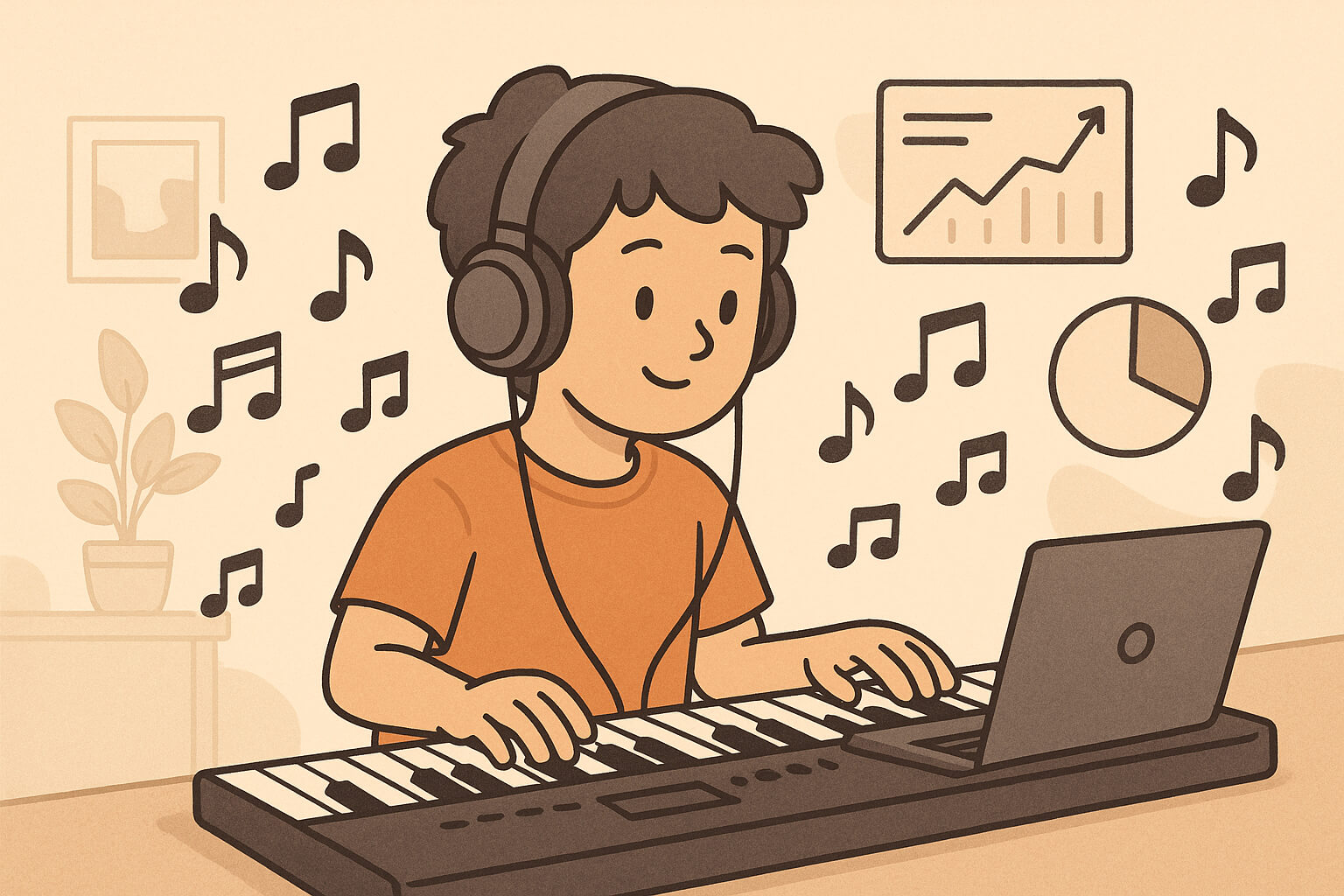Learning music from scratch can feel overwhelming at first—but don’t worry. With curiosity, commitment, and the right tools, you can build musical skills entirely on your own. Whether you want to strum a guitar, compose electronic beats, or read sheet music, this expanded guide will help you create a roadmap tailored to your goals.
1. Start with the Basics: Understanding Music Theory
Music theory is like the grammar of music. You don’t need to master it all at once, but understanding the basics will help you recognize patterns, read music, and create your own songs.
Focus on These Key Concepts:
- Notes and Pitches: Learn the names (A-G), sharps/flats, and how they repeat in octaves.
- Rhythm and Time: Understand note values (whole, half, quarter, eighth) and time signatures (like 4/4).
- Scales and Keys: Start with major and minor scales—these are the foundation of most music.
- Chords: Learn how chords are built (root, third, fifth) and how they relate to scales.
Recommended Free Resources:
Pro Tip: Don’t memorize everything—apply it to the songs you’re learning or writing.
2. Choose an Instrument (or Software) and Stick With It
Choosing the right starting tool is crucial. Commit to one instrument or digital tool for at least 3 months before switching.
Popular Beginner-Friendly Choices:
- Keyboard (Piano) – Visual layout makes music theory easier to understand.
- Guitar – Great for chord-based playing and songwriting.
- Voice – If you love to sing, your voice is your instrument.
- DAWs (Digital Audio Workstations) – For music production; try GarageBand, Cakewalk, or BandLab.
Tips for Success:
- Buy or borrow a budget-friendly instrument or download free software.
- Watch beginner tutorials to learn posture, hand positioning, and first exercises.
- Don't get distracted by new gear or switching tools too often.
Mindset Tip: Think of your instrument as your partner—grow with it!
3. Follow a Structured Learning Path
Without a teacher, you need structure. Create your own curriculum using free online lessons, books, or playlists to progress in a logical order.
Find or Build a Weekly Plan:
- Day 1-2: Learn new concepts (chords, scales, theory)
- Day 3-4: Apply concepts to a simple song
- Day 5: Practice ear training or improvisation
- Day 6-7: Review and record yourself
Free Resources to Follow:
Tip: Keep a practice journal to track progress and goals.
4. Practice Daily in Small Sessions
The key to building musical skill is consistent, mindful practice, not cramming long sessions once a week.
Ideal Practice Routine:
- 15–30 minutes daily (short and focused beats long and distracted)
- Work on one micro-goal at a time (e.g., playing one scale cleanly or switching between two chords)
- Record yourself weekly to track improvement
- Use metronomes or rhythm apps to keep time
Use These Practice Tools:
- TonalEnergy Tuner – Great for pitch accuracy
- Yousician, Fender Play, or Simply Piano – Interactive lessons
- Practice Makes Perfect Guide: Read it here
Motivation Tip: Celebrate each breakthrough—your first clear chord, a song you can play start to finish, or singing on pitch.
5. Develop Your Ear with Active Listening
Ear training sharpens your musical instincts. You'll better understand what you hear and improve your improvisation and transcription skills.
Start with:
- Identifying major vs. minor chords
- Recognizing intervals (distance between notes)
- Matching pitch by singing or playing by ear
Free Ear Training Tools:
- Ear Training Exercises
- SoundGym (Free version) – Gamified ear training
- Sing simple melodies like “Happy Birthday” and match them on your instrument
Pro Tip: Try transcribing melodies by ear before using sheet music—this builds a strong connection between sound and note.
6. Play Along with Backing Tracks & Real Songs
Once you have basic skills, start playing with real music. This builds timing, groove, and musicality in ways theory alone can't.
What to Do:
- Find a backing track in a key you know (C major is a good start)
- Play or sing along, staying in rhythm
- Try improvising simple melodies or rhythms
Useful Tools:
- YouTube Channels: Quist, Elevated Jam Tracks, Tracks Planet
- AI Tools: AI Music Generator
- Loopy or iReal Pro: Practice looping chord progressions
Challenge: Play a melody or solo with just 3 notes. Creativity > complexity.
7. Be Patient and Celebrate Small Wins
Music takes time. Progress is not always linear, and you’ll hit plateaus. Don’t quit during these moments—keep going.
Milestones Worth Celebrating:
- Learning your first full song
- Recording your first track
- Writing a short melody or beat
- Performing for friends or online
How to Stay Inspired:
- Join forums like Reddit’s r/musictheory or r/WeAreTheMusicMakers
- Share your progress on social media or music communities
- Remix or recreate songs you love
Mindset Reminder: Every musician started as a beginner. The only difference is they kept going.
Additional Free Resources to Help You
Final Words: Your Musical Journey Is Yours to Shape
You don’t need a music degree to become a musician. With the internet, persistence, and your own curiosity, you can go as far as you want.
Start small. Stick with it. Celebrate each step.
Whether you want to play covers, compose originals, or produce beats—you’re already on the path.
